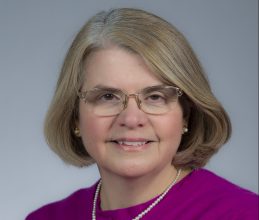
In the heat of the 2016 Democratic nomination contest, Sen. Bernie Sanders charged that former Secretary of State Hillary Clinton was “not qualified” to be president of the United States.[1] Sanders later conceded Clinton was, indeed, qualified.[2]
This dispute centered upon a person whose resume includes eight years of service in the U.S. Senate and four as secretary of state.
Any job applicant must convince someone that s/he is qualified for the position they seek. In the case of the presidency, the candidates need to first convince themselves—and then some millions of voters—that they have a combination of experience, credentials and vision needed to be successful at a job with incomparably diverse responsibilities and expectations. One way to make this case is to serve in a high-ranking executive or legislative elective office before seeking the presidency.
But seeking office is complicated by gender. Political scientists have found that potential women candidates often hold themselves to higher standards than men do—thinking they lack the knowledge or experience to serve in public office. Moreover, sexism, whether conscious or unconscious, means that women are often dogged by questions about their qualifications. The Clinton-Sanders dispute is just a particularly dramatic example.
So let’s take a look at the qualifications of the current field of Democratic candidates and see how they compare to previous major party nominees for president.
My approach
I limit this analysis to the “Modern Presidency,” which is defined by scholars as beginning with Franklin Roosevelt. With the expansion of government social programs and the elevation of the U.S. to a world power, today’s presidency is a much different job than it was in the 19th and early 20th centuries.
Table 1 is a side-by-side of resumes of presidential nominees from 1932-2016 (n=30)[3] and the current field of Democratic candidates (n=23). This information is compiled from publicly available biographies.[4] Examining a candidate’s political resume is relevant because women who have run for president in the past were discounted because they did not have the resumes needed to be seriously considered. Indeed, prior to this election cycle, only three women ever sought a major party presidential nomination had the requisite resume line: senators Margaret Chase Smith (R-ME) (1964), Carole Mosley Braun (D-IL) (2004) and Hillary Rodham Clinton (D-NY) (2008, 2016).
Table 1: The Resume Comparison
| Major Party Nominees, 1932-2016 | 2020 Democratic Field | |||
|---|---|---|---|---|
| Position | Ever Held | Highest at Nomination [5] | Ever Held | Highest in 2020 |
| Vice President | 8 | 8 | 1 | 1 |
| Governor | 11 | 11 | 3 | 3 |
| U.S. Senator | 14 | 7 | 8 | 7 |
| Veterans | 19 | 1 | 3 | 0 |
| U.S. House of Representatives | 6 | 0 | 9 | 6 |
| Cabinet-Level Appointments | 4 | 1 [6] | 1 | 1 |
| Mayor | 1 | 0 | 7 | 3 |
| Ambassador | 1 | 0 | 0 | 0 |
| Business Executive | 3 | 2 | 3 | 2 |
| Other | 14 | 0 | 5 | 0 |
Three usual paths to the nomination
The historical list shows that there are, principally, three paths to the presidential nomination: service as U.S. senator, governor or vice president. There are relatively few exceptions: veteran Eisenhower and business executives Donald Trump and Wendell Willkie. Needless to say, all of these occupations—the conventional and the uncommon—are male dominated.
The 2020 field
This leads to the first striking difference between the historical list of nominees and the current 2020 Democratic field: the large number of presidential candidates who lack the conventional qualifications for nomination. Indeed, only 11 of the 23 have the resume lines we would expect to see: service as vice president, senator or governor.
Conversely then, more than half of the 2020 Democratic presidential candidates are attempting to parlay experience as a U.S. House member, cabinet secretary, mayor and/or business executive into a major party nomination. Historically speaking, the odds are against such candidates.
A second major difference is that there are few veterans among the current candidates. This may be due to changing expectations for public officials. It’s probably also a reflection of the fact that Gen X-ers came of age during a period of relative peace—after the Vietnam War, before the Persian Gulf War and the wars in Iraq and Afghanistan. Notably the three veterans currently running for president are all veterans of these latter conflicts (Buttigieg, Moulton and Gabbard).
A third interesting difference is the rise of the mayor. From 1932-2016, only one major party nominee, Hubert Humphrey, had “mayor” on his resume. This year, we see seven candidates can boast the same. Even those like Cory Booker and John Hickenlooper, who have moved on to other elective offices, still tout their mayoral experiences in their stump speeches.
Yes, but is HE qualified?
When I compare the resumes of the men and women running for president this year, I am struck by how many women are qualified to be president of the United States by this measure. Four of the six women (66%) currently running meet the historic qualifications for a presidential nomination (Gillibrand, Harris, Klobuchar and Warren), which more than doubles the historical total. Indeed, they are a majority of the sitting U.S. senators currently in the race (four of seven or 57%) and fully one-third of the candidates who are qualified by historic standards. Indeed given that women are slightly more than a quarter of the field (27%), women are actually overrepresented among the candidates who are qualified by this standard.
While the three male senators (Sanders, Booker and Bennet) are arguably as well qualified as their female colleagues, only Joe Biden, as a former vice president and a former senator, is arguably more qualified than these women.
What’s even more impressive is that 2020 has attracted a relatively large number of women candidates (six) when the number of women currently in the pipeline remains fairly small. Only 25 women are currently serving in the U.S. Senate—almost half of the historical total. Only nine women are currently serving as governor, and no woman has ever been elected to the vice presidency. As small as these numbers are, they do provide the critical mass of women in the pipeline essential to get to this point.
The solid resumes of these four women senators points to what we see among women candidates at other levels. These women have overcome the “self talk” that says “Wait” and “You need to know more.” Indeed, these women fit another pattern: that women who run for federal office are stronger candidates in order to overcome unconscious biases and, frequently, multiple primary challengers.
By comparison, only seven of 17 men (41%) hold positions that have historically led to a nomination. This means that over half (10) of the men in the field are unqualified by this historic measure. Indeed, the story of the male candidates, collectively, is not “Wow, what a great pool of candidates!” It is really “Why so many candidates who are comparatively unqualified?”
In a future blog post, I will explore some possible gender dynamics that account for the unwieldy size of the field. Yet one thing is clear, voters and reporters should move beyond any reservations they have about women candidates and instead be asking of the men:
But is HE qualified?
[1] “Bernie Sanders: Hillary Clinton is not ‘qualified’ to be president.” April 7, 2016. CNN. Accessed: https://www.cnn.com/2016/04/06/politics/bernie-sanders-hillary-clinton-qualified/index.html.
[2] “Sanders Says ‘Of Course’ Clinton Is Qualified to Be President.” April 8, 2016. Time. Accessed: http://time.com/4286522/bernie-sanders-hillary-clinton-democrats-qualifications/.
[3] There were 22 presidential elections from 1932 to 2016 but only 31 major party nominees since some individuals were nominated more than once.
[4] This is, admittedly, an analysis from one particular perspective. It looks at historical precedent and offices held only. It does not attempt, or should it attempt, to answer questions that primary voters and caucus-goers must answer for themselves about temperament, record, platform, effectiveness, integrity and more.
[5] The vice presidents include Johnson, Truman and Ford who first became president upon a vacancy in office rather than through nomination and election. All were subsequently nominated and two were elected to the presidency in their own rights.
[6] Hillary Rodham Clinton, who also served as a U.S. senator.

Karen M. Kedrowski
Karen M. Kedrowski is the director of the Carrie Chapman Catt Center for Women and Politics at Iowa State University. Kedrowski previously served as the executive director of the John C. West Forum on Politics and Policy at Winthrop University where she also taught in the political science department and researched breastfeeding policy and breast cancer activism. She received her Ph.D. from the University of Oklahoma.